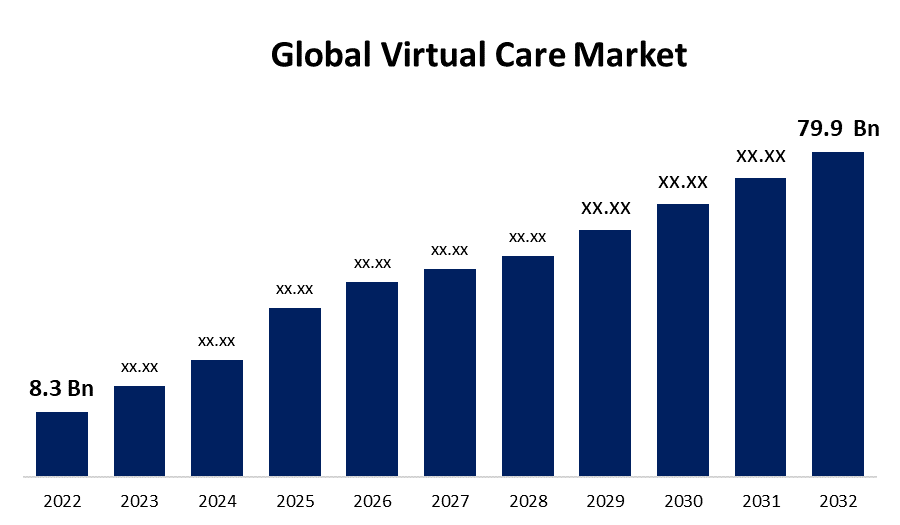Global Virtual Care Market Size, Share, and COVID-19 Impact Analysis, By Component (Software & Services, Hardware), By Consultation Type (Video, Audio, Messaging), By Application (Family Medicine, Internal Medicine, Pediatrics), By End User (Hospital & Clinics, Pharmacies), and By Region (North America, Europe, Asia-Pacific, Latin America, Middle East, and Africa), Analysis and Forecast 2022 - 2032
Industry: HealthcareGlobal Virtual Care Market Size Insights Forecasts to 2032
- The Global Virtual Care Market Size was valued at USD 8.3 Billion in 2022
- The Market Size is Growing at a CAGR of 25.41% from 2022 to 2032
- The Worldwide Virtual Care Market Size is expected to reach USD 79.9 Billion by 2032
- Asia Pacific is expected to grow the fastest during the forecast period

Get more details on this report -
The Global Virtual Care Market size is anticipated to exceed USD 79.9 Billion by 2032, growing at a CAGR of 25.41% from 2022 to 2032.
Market Overview
Virtual care is primarily a virtual or official visit between the patient and the hospital via communication technology. One of the major types of interaction among technologies that allows virtual meetings to take place in real time is audio or video connectivity. It enables patients from all over the world to interact with one another in real time. Virtual care is associated with real-time interactions, the elimination of geographical barriers, cost and time consumption, and other factors. It also has a lot of advantages in disease management, which necessitates regular follow-up. Furthermore, one of the primary factors driving market growth is the common benefits provided by virtual care for doctors and patients. Patients can benefit from virtual care by receiving consultations from the comfort of their own homes. It also assists them in bridging the gap between patient and doctor, as doctors can now reach a larger number of patients globally. One of the primary drivers of the virtual care market is the increasing adoption of IT services in healthcare organizations. Healthcare professionals are widely utilizing IT services to help them and their patients communicate more effectively.
Report Coverage
This research report categorizes the market for the global virtual care market based on various segments and regions and forecasts revenue growth and analyzes trends in each submarket. The report analyses the key growth drivers, opportunities, and challenges influencing the virtual care market. Recent market developments and competitive strategies such as expansion, product launch, and development, partnership, merger, and acquisition have been included to draw the competitive landscape in the market. The report strategically identifies and profiles the key market players and analyses their core competencies in each sub-segment of the virtual care market.
Global Virtual Care Market Report Coverage
| Report Coverage | Details |
|---|---|
| Base Year: | 2022 |
| Market Size in 2022: | USD 8.3 Billion |
| Forecast Period: | 2022-2032 |
| Forecast Period CAGR 2022-2032 : | 25.41% |
| 2032 Value Projection: | USD 79.9 Billion |
| Historical Data for: | 2020-2021 |
| No. of Pages: | 200 |
| Tables, Charts & Figures: | 115 |
| Segments covered: | By Component, By Consultation, By Application, By End User, By Region |
| Companies covered:: | American Well, AMD Global Telemedicine, CHI Health, AT&T, Cerner Corporation, GE Healthcare, Koninklijke Philips N.V., MDLIVE, Siemens Healthcare, United Healthcare Services, VeeOne Health, eVisit, MEDITECH, Caregility, Teladoc Health, And Others. |
| Pitfalls & Challenges: | Covid-19 Empact,Challenges,Growth, Analysis, |
Get more details on this report -
Driving Factors
Rapid technological advancement has significantly accelerated the virtual care market. High-speed internet, modern mobile devices, and the development of secure, accessible remote platforms have transformed healthcare service delivery. This technology enables real-time video consultation, secure messaging, and intensive monitoring, resulting in a more inclusive and interactive healthcare experience. In virtual care services, AI and data analytics augment diagnostic capabilities and enable more personalized treatment plans. Additionally, virtual care platforms enable easy access to healthcare experts, reducing the need for physical travel and overcoming logistical challenges. As a result, patients can seek medical advice and treatment more easily, leading to improved health outcomes.
Restraining Factors
The virtual care landscape is governed by difficult and evolving regulations that vary by region and jurisdiction. These regulations and policies may have an impact on the types of services that can be provided through virtual platforms, as well as impose restrictions on licensure, data privacy, and security.
Market Segmentation
The Global Virtual Care Market share is classified into application, consultation type, and end user.
- The family medicine segment is expected to hold a significant share of the global virtual care market during the forecast period.
The global virtual care market is categorized by application into family medicine, internal medicine, pediatrics. Among these, the family medicine segment is expected to hold a significant share of the global virtual care market during the forecast period. The high number of online consultations for chronic and primary care is the primary reason for the market segment's strong position.
- The audio segment is expected to hold the largest share of the global virtual care market during the forecast period.
Based on the consultation type, the global virtual care market is divided into video, audio, and messaging. Among these, the audio segment is expected to hold the largest share of the global virtual care market during the forecast period. The main factors driving the growth of the virtual care market are easy accessibility and a preference for audio calls. Many people live on the other side of the digital divide, where access to technology and high-speed internet services is limited. Individuals who prefer audio consultation have proven to be successful in overcoming barriers to good care, such as some mobility causes, a lack of transportation, and a lack of nearby healthcare providers.
- The hospital & clinics segment is expected to hold the largest share of the global virtual care market during the forecast period.
Based on the end user, the global virtual care market is divided into hospital & clinics and pharmacies. Among these, the hospital & clinics segment is expected to hold the largest share of the global virtual care market during the forecast period. Because of their role as central hubs for intensive healthcare services, hospitals and clinics dominate the end-user segment of the virtual care market. They have the necessary services, resources, and skilled professionals to successfully implement and maintain virtual care platforms. Hospitals also serve a diverse patient population with a wide range of healthcare needs, making virtual care an important tool for extending services beyond in-person visits.
Regional Segment Analysis of the Global Virtual Care Market
- North America (U.S., Canada, Mexico)
- Europe (Germany, France, U.K., Italy, Spain, Rest of Europe)
- Asia-Pacific (China, Japan, India, Rest of APAC)
- South America (Brazil and the Rest of South America)
- The Middle East and Africa (UAE, South Africa, Rest of MEA)
North America is anticipated to hold the largest share of the global virtual care market over the predicted timeframe.

Get more details on this report -
North America is projected to hold the largest share of the global virtual care market over the predicted years. The region's growth can be attributed to a variety of factors, including increased adoption of virtual care models, geographic expansion of market players, a surge in virtual healthcare startups, and expanding services introduced by major key players operating in this region. Because of its early adoption and rapid integration of virtual care services, the United States currently leads the virtual care sector, while the United Kingdom is also emerging as a significant player in this market.
Asia Pacific is expected to grow at the fastest pace in the global virtual care market during the forecast period. The Asia Pacific virtual care market is expanding in response to the growing demand for more convenient and easily accessible healthcare services. As technology advances, it is more likely that the virtual care market will grow and benefit both patients and healthcare providers. The growth rate of the virtual care market in developed countries is impressive, with an increasing number of patients and healthcare providers recognizing the benefits of virtual visits over traditional office visits, particularly for non-emergency and urgent care needs.
Competitive Analysis:
The report offers the appropriate analysis of the key organizations/companies involved within the global virtual care along with a comparative evaluation primarily based on their product offering, business overviews, geographic presence, enterprise strategies, segment market share, and SWOT analysis. The report also provides an elaborative analysis focusing on the current news and developments of the companies, which includes product development, innovations, joint ventures, partnerships, mergers & acquisitions, strategic alliances, and others. This allows for the evaluation of the overall competition within the market.
Recent Developments:
- In October 2023, Newfoundland and Labrador (N.L.) launched a new virtual-care initiative for residents who do not have a family doctor. This innovative system will provide individuals without a primary-care provider with physician access, as well as round-the-clock emergency coverage for rural areas and remote emergency departments.
List of Key Companies
- American Well
- AMD Global Telemedicine
- CHI Health
- AT&T
- Cerner Corporation
- GE Healthcare
- Koninklijke Philips N.V.
- MDLIVE
- Siemens Healthcare
- United Healthcare Services
- VeeOne Health
- eVisit
- MEDITECH
- Caregility
- Teladoc Health
- Others
Key Target Audience
- Market Players
- Investors
- End-users
- Government Authorities
- Consulting And Research Firm
- Venture capitalists
- Value-Added Resellers (VARs)
Market Segment
This study forecasts revenue at global, regional, and country levels from 2020 to 2032. Spherical Insights has segmented the Global Virtual Care Market based on the below-mentioned segments:
Global Virtual Care Market, By Component
- Software & Services
- Hardware
Global Virtual Care Market, By Consultation Type
- Video
- Audio
- Messaging
Global Virtual Care Market, By Application
- Family Medicine
- Internal Medicine
- Pediatrics
Global Virtual Care Market, By End-User
- Hospital & Clinics
- Pharmacies
Global Virtual Care Market, By Region
- North America
- US
- Canada
- Mexico
- Europe
- Germany
- UK
- France
- Italy
- Spain
- Russia
- Rest of Europe
- Asia Pacific
- China
- Japan
- India
- South Korea
- Australia
- Rest of Asia Pacific
- South America
- Brazil
- Argentina
- Rest of South America
- Middle East & Africa
- UAE
- Saudi Arabia
- Qatar
- South Africa
- Rest of Middle East & Africa
Need help to buy this report?